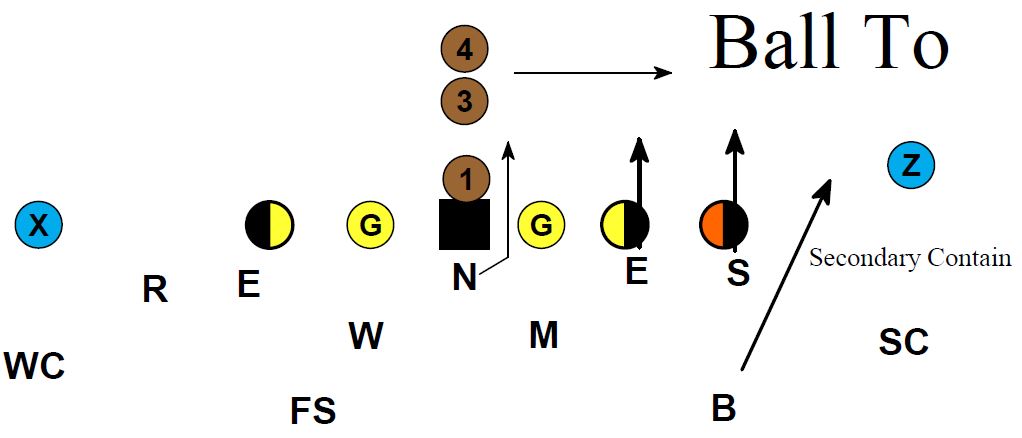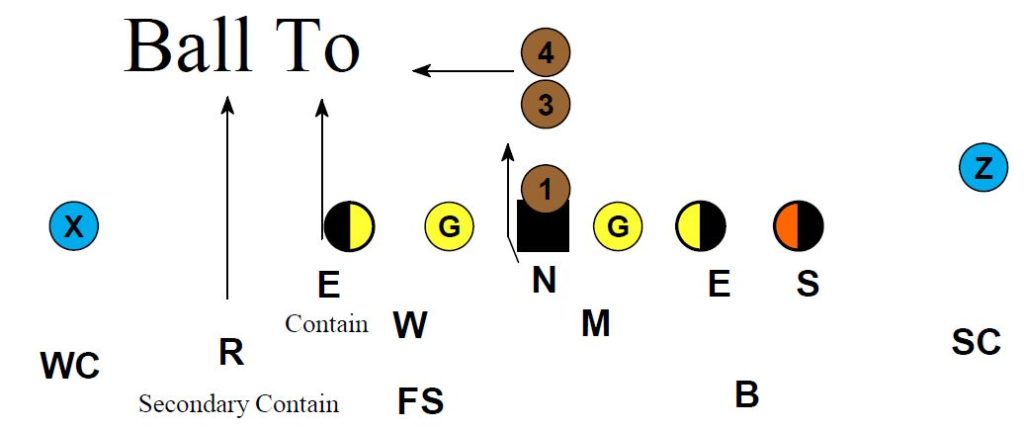Stimulus Response: Reinforcing The Learning Curve Defensive Line Understanding Blocking Schemes
| A. Stimulus (Coach) | A. Response (Player) |
| 1. Base Block | 1. Squeeze |
| 2. Down Block | 2. Trap |
| 3. Reach Block | 3. Push Pull |
| 4. Pass Set | 4. Bull Rush |
| B. Stimulus (Coach) | B. Response (Player) |
| 1. Squeeze | 1. Base Block |
| 2. Trap | 2. Down Block |
| 3. Push Pull | 3. Reach Block |
| 4. Bull Rush | 4. Pass Set |
Stimulus response teaching of responsibilities is a method by which you can reinforce understanding. As the examples above for defensive linemen illustrate. The above stimuluses represent what you might consider for your defensive lineman when prompted by the coach.
Base Block is the coaches comand and the technique you might want to hear back from your player might be “squezze” the technique used to combat a base block by an offensive lineman or the coach could say “squezze” looking for his player to say “base” the type of block that he might face in a game.
A linebacker stimulus which you will see in the following pages would sound like this as presented to his linebackers by the position coach.
Coaches stimulus “A” Gap / Players Response “Dive” your athletes reaction to the ball running in “A” Gap also followed by this is the technique incorprated to his reaction to an “A” gap gap play might be “Stay”.
As you read through this manual you will be able to better understand how the stimulus response method to reinforcing learning works. This type of teaching can be incorprated into all your position coaches approach to coaching.
Run Block Stimulus Response Defensive Nose and Ends
| A. Stimulus (Coach) | A. Response (Player) |
| 1. Base Block | 1. Squeeze |
| 2. Down Block | 2. Trap |
| 3. Reach Block | 3. Push Pull |
| 4. Pass Set | 4. Bull Rush |
| B. Stimulus (Coach) | B. Response (Player) |
| 1. Squeeze | 1. Base Block |
| 2. Trap | 2. Down Block |
| 3. Push Pull | 3. Reach Block |
| 4. Bull Rush | 4. Pass Set |
Definitions
1. Base Block – Offensive lineman blocking straight ahead.
2. Down Block – Inside release by offensive lineman.
3. Reach Block – Offensive lineman working to get his helmet to the outside of the defender.
4. Pass Set – Offensive lineman giving a high hat read.
5. Trap – a long pull that crosses the center to block an over penetrating defender.
6. Push Pull – A technique used by a defender to escape the block of an over extended blocker.

Run Block Stimulus Response Defensive Ends and Nose
| A. Stimulus (Coach) | A. Response (Player) |
| 1. Double Team | 1. Drop |
| 2. Shaded Play To | 2. Front Door |
| 3. Shaded Play Away | 3. Back Door |
| 4. Wash Down | 4. Spin |
| B. Stimulus (Coach) | B. Response (Player) |
| 1. Drop | 1. Double Team |
| 2. Front Door | 2. Shaded Play To |
| 3. Back Door | 3. Shaded Play Away |
| 4. Spin | 4. Wash Down |

Run Block Stimulus Response Defensive Ends and Nose
Definitions
| A. Stimulus (Coach) | A. Response (Player) |
| 1. Arc (DE) | 1. Close |
| 2. Veer Release | 2. Eyes Inside |
| 3. Influence | 3. Trap |
| 4. Deep Set | 4. Eyes Inside |
| 5. Short Pull | 5. Eyes Inside |
| 6. Long Pull | 6. Hip Pocket |
| B. Stimulus (Coach) | B. Response (Player) |
| 1. Close | 1. Arc (DE) |
| 2. Eyes Inside | 2. Veer Release |
| 3. Trap | 3. Influence |
| 4. Eyes Inside | 4. Deep Set |
| 5. Eyes Inside | 5. Short Pull |
| 6. Hip Pocket | 6. Long Pull |
1. Arc – Outside release by a Tight End.
2. Veer Release – An inside release by an Offensive Tackle.
3. Influence – Technique used by an offensive lineman to get a defender to react.
4. Eyes Inside – The reaction by a down defender vs an inside or veer release.
5. Short Pull – Guard drop stepping an pulling outside and not crossing the center.
6. Hip Pocket – Term that discribes a defender following a pulling offensive lineman.
7. Long Pull – The pulling of an offensive lineman that crosses the butt of the center.
Stimulis response to the following situations listed above should be incorporated into a drill that will teach the desired outcome. It is important to remember that a defensive lineman should never penetrate deeper than a 1 1/2 yards working off the back heels of the offensive line. When over penetrating this sets up the offense to take advantage of this by running trap schemes.
About the Author of this post:
Jerry Campbell has over 30 years of high school and college coaching experience. He has experience as a head coach, offensive coordinator, and various position coaches. He has written numerous football coaching articles in various publications, is the author of over 30 books on coaching football, and has produced 12 coaching video series. Additionally, he is a nationally sought after speaker on the coaching clinic circuit.